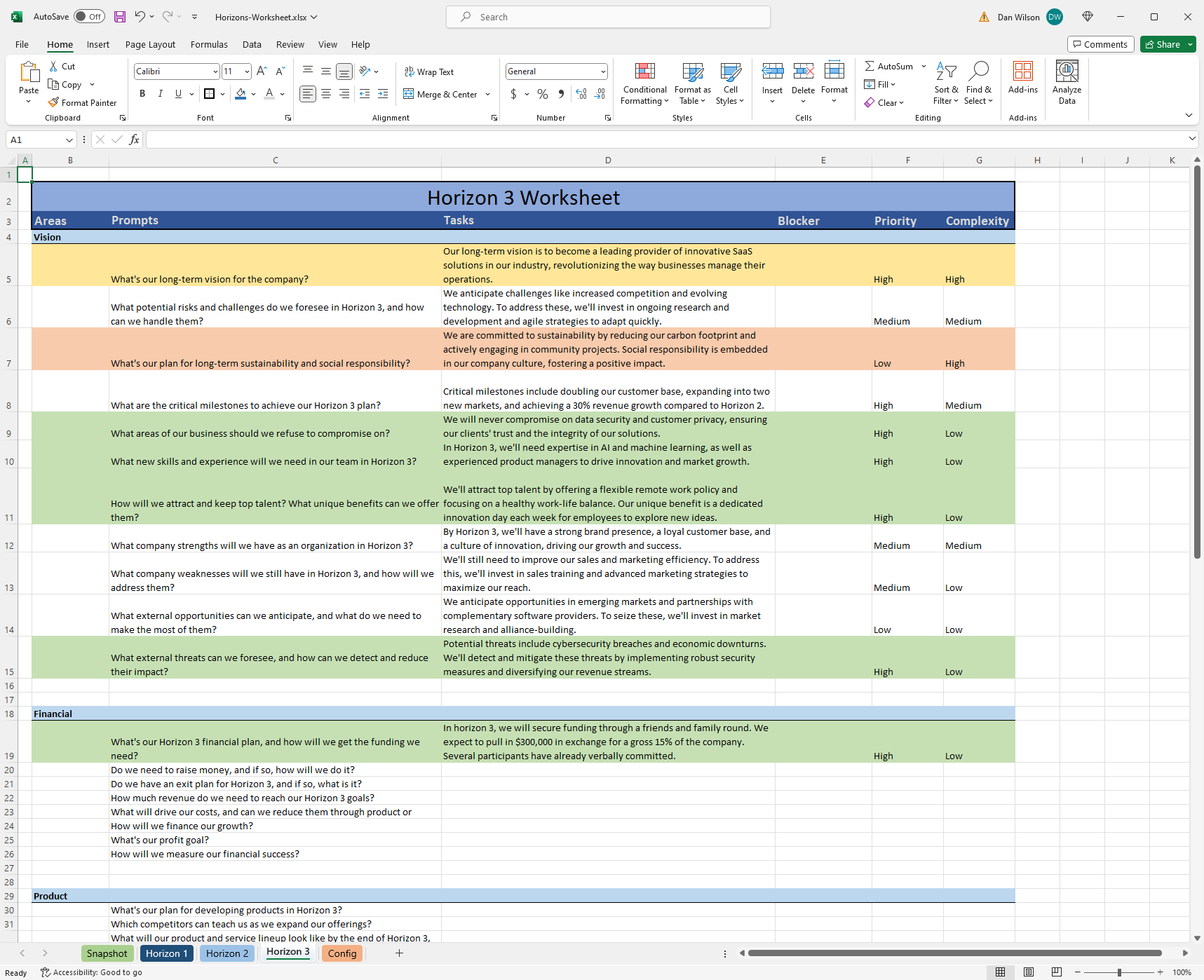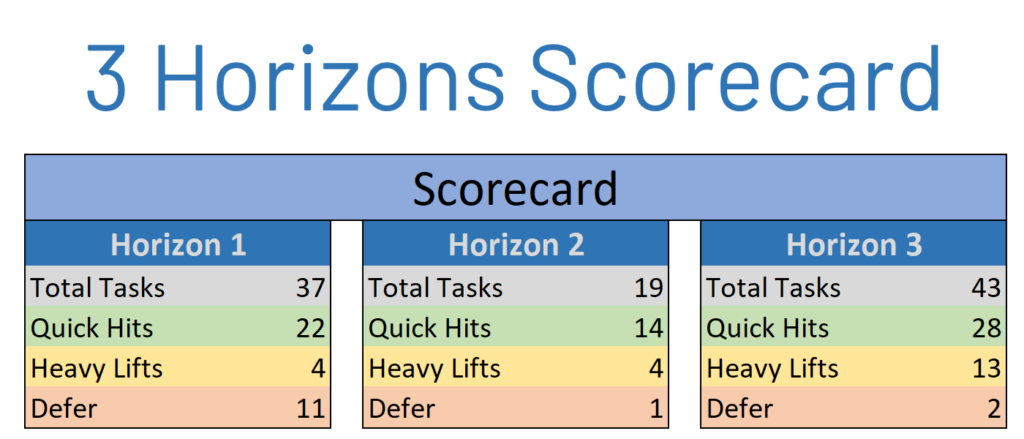
I’ve developed a powerful tool—a comprehensive spreadsheet—to streamline your business planning, ensuring you focus on what truly matters. Get your copy of the spreadsheet, along with the explainer video here.
Running a business can feel like juggling chainsaws in a hurricane. Ideas fly, priorities shift, and the future seems hazy. But fear not, here’s a clear-eyed approach to planning and prioritizing your activities for maximum impact: the 3 Horizon System.
Think of it as three concentric circles, each representing a different timeframe and level of certainty. Horizon 1 is your immediate orbit. It’s where you execute, tackling well-defined tasks with minimal external dependencies. Think of it as your daily to-do list, fueled by laser focus.
Next comes Horizon 2. This is where your vision starts to take shape. You’ll craft initiatives, navigate uncertainties, and manage tasks with external dependencies, like that elusive client signature. Imagine it as your roadmap for the next quarter, guiding your strategic bets.
Finally, we have Horizon 3: your visionary landscape. Here, you paint the big picture. What does your company look like in three years? What audacious goals will you chase? This long-term vision will inform your Horizon 2 and 1 actions, ensuring every step you take aligns with your ultimate destination.
Now, let’s put this framework into action! I’ve created a free spreadsheet packed with 100 prompts to help you navigate each Horizon. No more staring at a blank page, wondering where to begin. Just open the template, click on the relevant tab, and start brainstorming!

How the 3 Horizon System Helps You Organize Your Business
Let’s break down the system to get you up to speed. The 3 Horizon framework segments your business activities into 3 time frames:
- Horizon 3 (1-3 years): A visionary outlook for your business—your ultimate goals, strategies, product releases, growth plans, and sustainability considerations.
- Horizon 2 (1-3 months): Tasks and initiatives you aim to achieve in the near future. These involve managing uncertainties, plotting external dependencies, and probabilities. In a well functioning business, Horizon 2 activities are informed by Horizon 3.
- Horizon 1 (1-3 weeks): Immediate tasks and projects that are well-defined and often fill your day-to-day operations. This can be the most difficult place to work, because there is so much to do!
You will define your longer term goals, and break them down into actionable components and milestones. The items in Horizon 3 form the basis for Horizon 2 and Horizon 1 activity.
Using the Spreadsheet Template for Business Planning
Upon opening the spreadsheet and heading to the ‘Snapshot’ tab, you’ll find a breakdown of your tasks categorized by their respective horizons. Here’s a quick guide to understanding the columns:
- Prompt: A repository of 100 prompts across Horizon 2 and 3 designed to stimulate your planning process.
- Task: Document the tasks or initiatives you plan to undertake, ensuring they are appropriately sized for the respective horizon.
- Blocker: Specify the reasons hindering task completion, be it external dependencies or pending market events.
- Priority & Complexity: Assign priority levels and complexity ratings to tasks. Be ruthlessly focused on the priority within each horizon and evaluate complexity objectively.
No more staring at a blank page, wondering where to begin. Just open the template, click on the relevant tab, and start brainstorming. You shouldn’t try to do all sections at once, just pick a few areas to work on at a time.
Scoring Methods For Business Activity Planning
When you score your Horizon 3 and Horizon 2 activities, the spreadsheet will categorize items for you. The categories are designed to inform your prioritization so you can organize the items and tasks in the most productive manner. The scoring categories are:
- Quick Hits: High Priority, Low Complexity tasks. It might make sense to prioritize these first since you can get them done with lower effort, and they will provide a valuable impact to your business.
- Heavy Lifts: High Priority, High Complexity tasks. These are most often important hard things. You only have so much capacity so choose these wisely.
- Defers: Low Priority, High Complexity tasks. These warrant a look to see how far you can kick the proverbial can down the road.
Once your items are scored, go through and make sure you agree with the outcome. The ideal scenario is you have a list of easy to do, high value items you can start right away, followed by harder tasks you either need to break down further, or get rid of. By the end of this exercise, you’ll have a better idea of how you could spend your time, and some triggers to make decisions on low value work that somehow ended up on your list.

Leveraging Each Horizon
- Horizon 3: Craft your long-term vision here. Define your company’s direction, strategies, and growth plans. Remember, a clear vision fuels effective short-term planning.
- Horizon 2: Plan closer into the future, balancing clarity with uncertainties. These tasks often evolve into immediate Horizon 1 tasks, so keep them in focus.
- Horizon 1: Detail tasks that directly impact your day-to-day operations. Keep it focused and avoid cluttering this space with non-essential items.
Maximizing Efficiency
As you progress and complete tasks within each horizon, revisit and update your Horizon 3 vision. Remember, this isn’t just about planning; it’s a dynamic process that evolves as your business grows. Once you’ve filled out your Horizon 3 plan, it’s best to revisit the plan every 3 to 6 months. There is a necessary balance between longer term thinking, and short term “Get-it-done” work.
Emphasizing Priorities
Utilize the spreadsheet’s scorecard feature, which automatically calculates ‘quick hits,’ ‘heavy lifts,’ and ‘defers.’ Aim for a balanced scorecard—avoiding a list dominated by high-priority tasks—to ensure a well-rounded approach to business planning. The right balance depends on your company stage and what you have going on at the time. It’s common for leaders to move between the horizons as necessary, so don’t beat yourself up if you need to change focus for a while. Just make sure to set a reminder to get back to a balanced business vision.
Closing Thoughts
Success in business isn’t a straight line. It’s about adaptability, smart planning, and prioritizing what truly moves the needle for your venture. So, take a moment to download the free template and kickstart your business planning journey.
I value your feedback! Drop a comment on the explainer video and share the type of business you’re building. Your input shapes the content I create to better support your entrepreneurial journey. Here’s to your business’s success—let’s build something great together!

